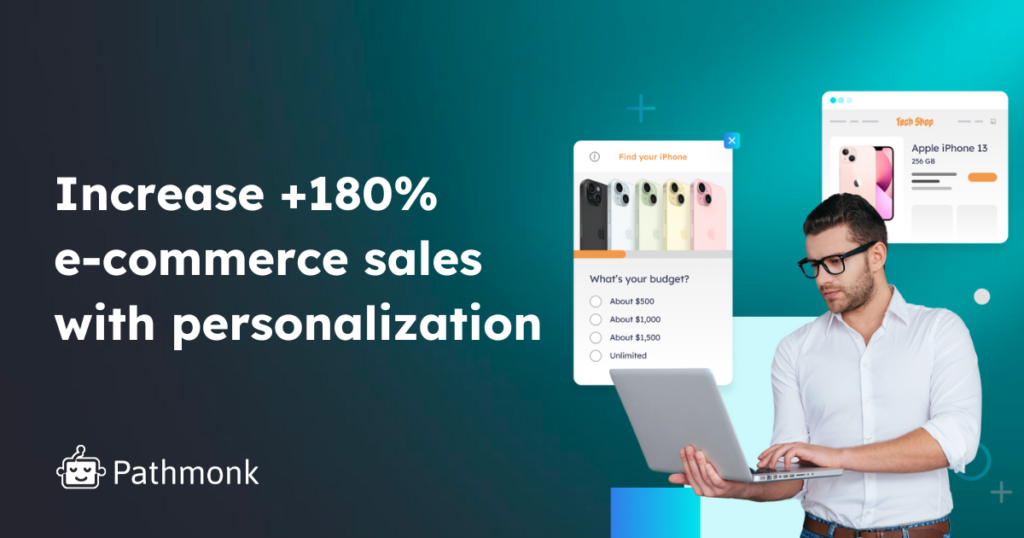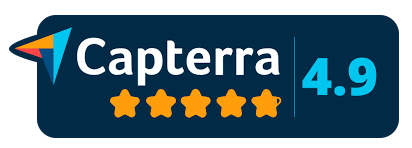
Uncomfortable truth: marketing is getting more expensive than ever.
Even if you’re tracking all the right metrics, integrating all your channels and generating some quality leads, are you really using your marketing analytics to maximize your results?
Some marketing analytics tools will give you pretty dashboards but lack depth. Others track everything—but leave you drowning in data with no actionable insights.
So, how do you find a marketing analytics tool that actually moves the needle?
Here’s our take on the best marketing analytics tools available, their key benefits and limitations.
Let’s jump right in 🚀
Table of Contents
Pathmonk

Get actionable insights on your customer journey while directly impacting conversions with intent-based personalized experiences!
On top of providing detailed analytics and data-driven insights on user behavior, Pathmonk stands out in its ability to dynamically create intent-based personalized user experiences using predictive analytics, increasing conversion rates up to 180%!

While many marketing analytics tools are excellent at providing data for you to analyze and optimize, Pathmonk goes one step further by making customer journey optimization process proactive and real-time. By adapting website content to the visitor’s intent as they browse, Pathmonk directly impacts conversions rather than just informing about them.
Unlike other marketing analytics tools, Pathmonk doesn’t require complicated setups or technical expertise to work effectively. With its one-click activation, Pathmonk automatically identifies user intent and dynamically personalizes content for each visitor. This streamlined approach allows marketers to focus on strategy rather than on setup.

Pathmonk leverages AI to analyze user behavior using cookieless tracking, without compromising data privacy. This innovation sets Pathmonk apart, as it offers businesses the opportunity to maintain high-performance marketing analytics while staying compliant.
Good for: Using analytics and data-driven insights on customer journey to automatically create intent-based personalized user experience that increases conversions.
Discover how to:
- Understand your customer journey analytics
- Identify companies visiting your website for targeted ABM
- Effectively track and analyze multi-channel funnels
- Solve attribution challenges for a realistic performance overview
- Uncover consumer insights without tracking
Main features:
- Real-time behavioral analysis
- Monitoring alerts
- Bot traffic detection
- Conversational analytics
- Cookieless, automated tracking
- No-code set up
- Custom journey trigger capabilities
- Conversion rate optimization insights
- Unique insights into customer behavior
Increase +180%
leads
demos
sales
bookings
from your website with AI
Get more conversions from your existing website traffic delivering personalized experiences.

Hotjar
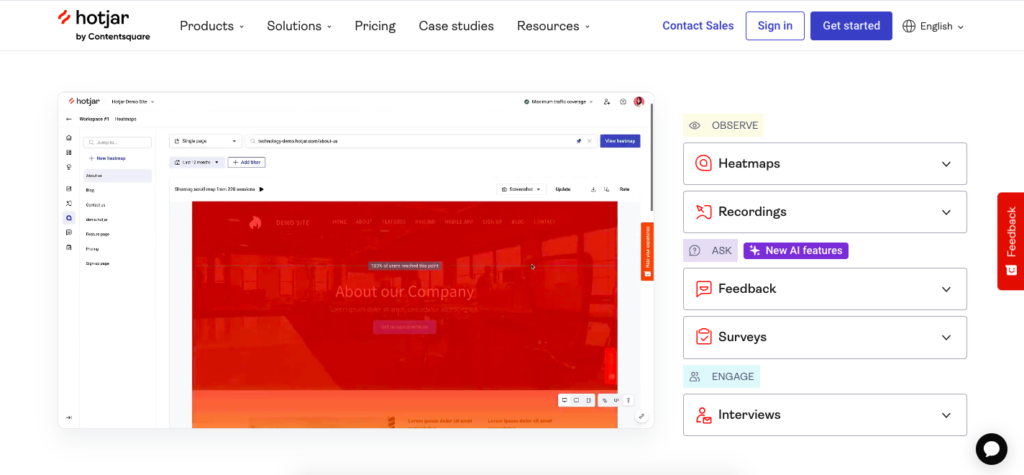
Hotjar is a user experience analytics platform that offers tools such as heatmaps, session recordings, and feedback surveys to help businesses understand how users interact with their websites. By visualizing user behavior, Hotjar enables companies to identify areas of improvement in site design and functionality, facilitating data-driven decisions to enhance user experience.
A standout feature is its heatmaps, which provide a visual representation of where users click, move, and scroll on a webpage. This insight allows businesses to assess which elements attract attention and which are overlooked, informing design optimizations.
Additionally, session recordings offer a replay of individual user sessions, revealing navigation patterns and potential pain points in the user journey. Feedback tools, including surveys and polls, enable the collection of qualitative data directly from users, offering context to the quantitative data gathered.
However, while Hotjar excels in providing visual behavior analytics, it has limitations in advanced data analysis compared to other marketing analytics tools. For instance, Hotjar focuses primarily on qualitative insights and may not offer in-depth quantitative metrics.
Additionally, on high-traffic websites, Hotjar may implement data sampling, which can limit the comprehensiveness of the data collected. Furthermore, some users have reported that the platform’s performance can impact website loading times due to multiple tracking tags.
Good for: Visualizing user behavior and gathering direct user feedback to inform website design and improve user experience.
Main features:
- Heatmaps displaying user click, move, and scroll behavior.
- Session recordings to replay individual user sessions.
- Surveys and feedback polls for collecting user opinions.
- Conversion funnels to identify drop-off points in user journeys.
- Form analytics to analyze user interactions with web forms.
Limitations:
- Lacks advanced quantitative analytics.
- Data sampling on high-traffic sites.
- Can impact website performance.
- Not ideal for complex funnel tracking.
Free on-page SEO template
Improve your rank and website traffic with this step-by-step guide to on-page SEO.
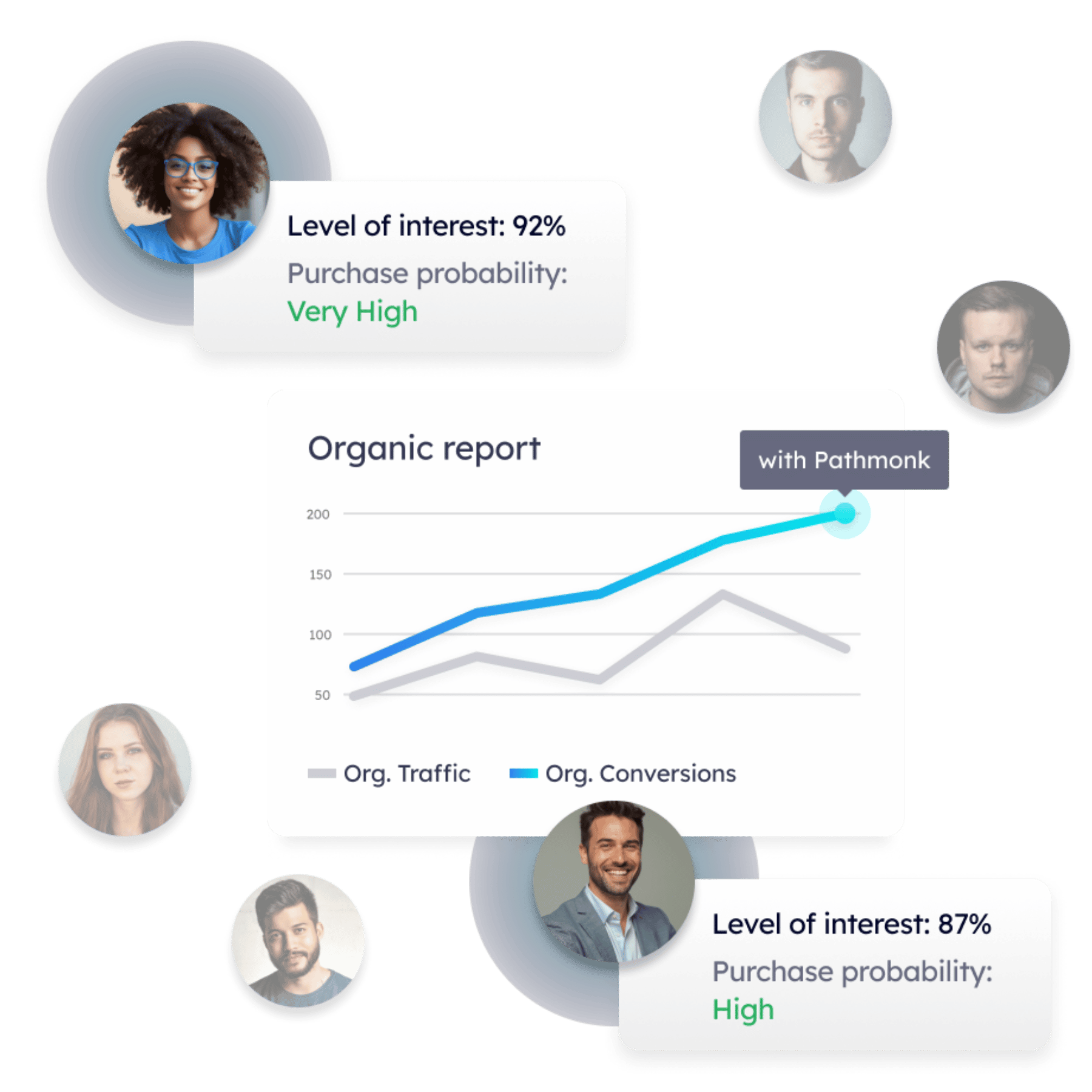
Heap
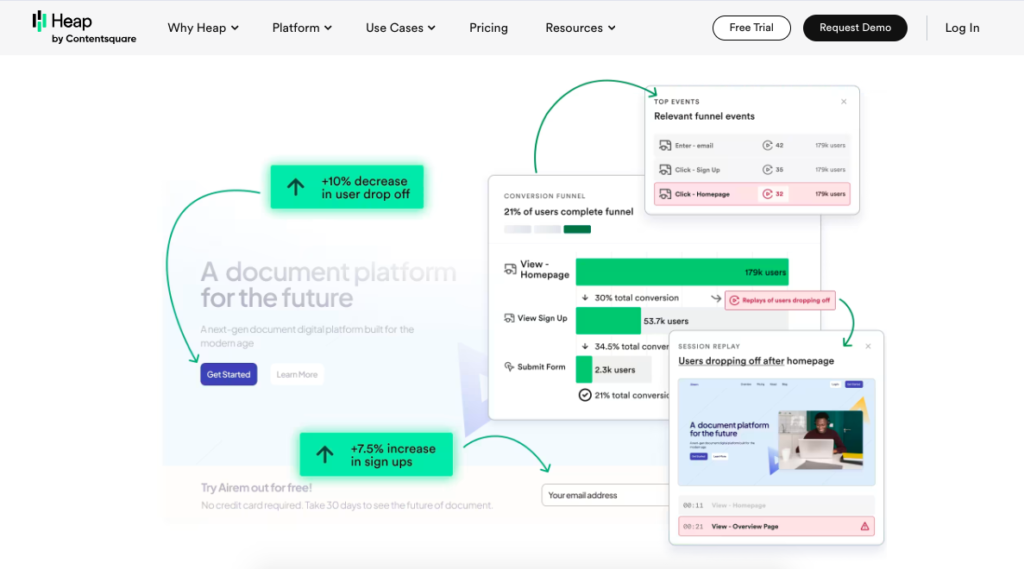
Heap is a product analytics platform that automatically captures all user interactions within a website or application, providing a comprehensive dataset for analysis.
This autocapture approach eliminates the need for manual event tracking, allowing businesses to retroactively define events and analyze user behavior without prior configuration. Heap’s platform offers tools such as funnel analysis, retention tracking, and cohort analysis to help teams understand and optimize the user journey.
A key advantage of Heap is its ability to retroactively analyze user interactions. Since all events are captured automatically from the moment of installation, businesses can define and examine events after the fact, providing flexibility in analysis. Additionally, Heap’s session replay feature allows teams to view individual user sessions, offering qualitative insights into user behavior that complement quantitative data.
While Heap’s comprehensive data collection is powerful, it can lead to challenges. The sheer volume of captured data may require significant storage and can complicate data management. Users have reported that navigating and organizing this extensive dataset can be complex, potentially leading to a steep learning curve for those new to the platform.
Additionally, Heap’s pricing model, which is based on session volume, can become costly for high-traffic websites, making it less accessible for smaller businesses or startups.
Good for: Organizations seeking automatic, comprehensive data capture for in-depth product and user behavior analysis.
Main features:
- Automatic capture of all user interactions without manual event tagging.
- Retroactive event definition and analysis.
- Funnel analysis to identify drop-off points in user flows.
- Retention analysis to track user engagement over time.
- Session replay for qualitative insights into individual user experiences.
Limitations:
- High data volume management.
- Steep learning curve.
- Pricing scales with data volume.
- Limited integrations.
Supermetrics
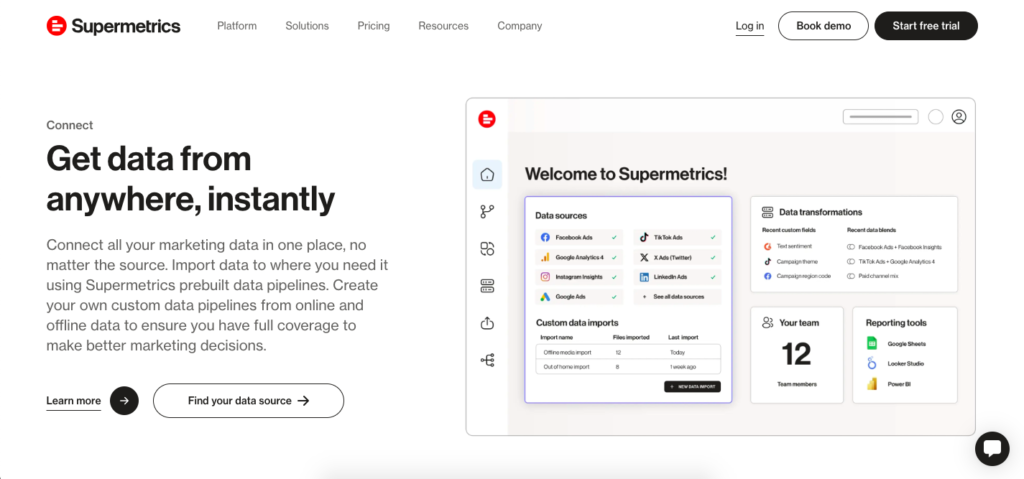
Supermetrics streamlines the collection of marketing data from various platforms into centralized destinations like Google Sheets, Data Studio, Excel, and data warehouses. By connecting to multiple data sources such as Google Analytics, Facebook Ads, and LinkedIn Ads, Supermetrics automates the data extraction process, enabling marketers to create reports and dashboards without manual data wrangling.
One of the primary advantages of Supermetrics is its extensive range of data connectors, supporting over 60 platforms, which allows for a holistic view of marketing performance across channels. However, some users have reported occasional issues with data loading and transfer, leading to discrepancies between Supermetrics and other analytics tools.
The tool also offers customizable reporting capabilities, enabling users to tailor reports to specific needs and automate data refreshes to ensure up-to-date insights. Additionally, Supermetrics provides scheduling features, allowing reports to be sent automatically via email or other preferred methods.
On the other hand, the platform’s pricing structure can be a concern, especially for smaller businesses, as costs can escalate with the addition of more data sources or destinations. Furthermore, some users have expressed dissatisfaction with customer support responsiveness, noting delays in addressing issues.
Good for: Aggregating and automating marketing data from multiple platforms into centralized reports and dashboards.
Main features:
- Integration with over 60 data sources, including major advertising and analytics platforms.
- Customizable reporting and dashboard creation in tools like Google Sheets and Data Studio.
- Automated data refreshes and scheduled reporting.
- Data transformation and blending capabilities for comprehensive analysis.
- User-friendly interface with pre-built templates for quick setup.
Limitations:
- Not a standalone analytics tool.
- Can experience data inconsistencies.
- Expensive for small businesses.
- Customer support responsiveness.
Understand your customer journey analytics
See how your users behave, find drop-offs, and receive actionable insights with AI.

Google Analytics 4 (GA4)
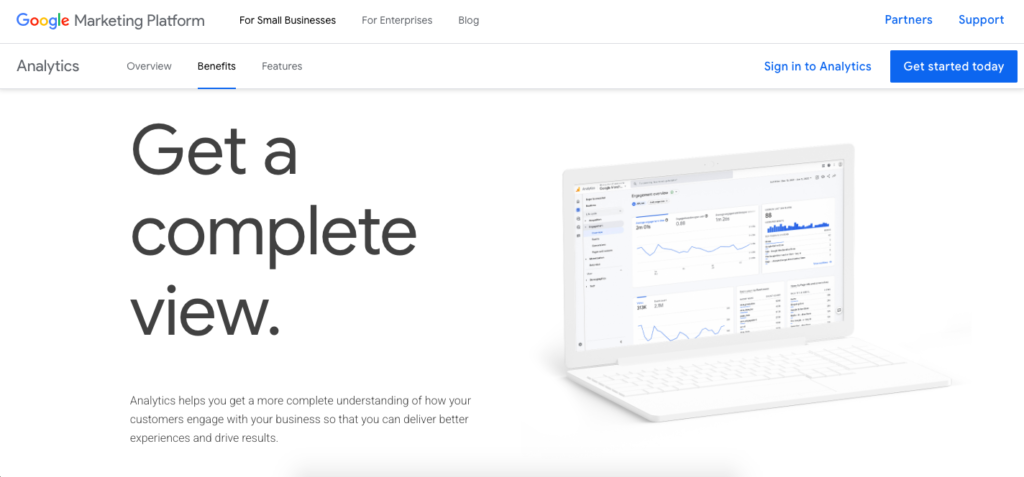
Google Analytics 4 (GA4) is Google’s latest iteration of its analytics platform, designed to provide a comprehensive understanding of user interactions across websites and applications.
Unlike its predecessor, Universal Analytics, GA4 employs an event-driven data model, capturing detailed insights into user behaviors such as clicks, page views, and transactions. By leveraging advanced algorithms, GA4 can generate predictive metrics, allowing businesses to anticipate user actions and tailor their strategies accordingly.
Additionally, GA4 offers enhanced data privacy controls, aligning with global regulations by minimizing reliance on cookies and providing more granular data retention options. This ensures that organizations can maintain compliance while still gaining valuable insights.
That said, the event-based model may require significant configuration effort compared to the plug-and-play nature of Universal Analytics. Users often report a steep learning curve, especially for those unfamiliar with advanced event tracking setups.
GA4 also introduces a more customizable reporting interface. Users can create bespoke dashboards and reports that focus on the metrics most relevant to their objectives. The platform’s Explore section facilitates in-depth analysis through customizable reports tailored to specific business needs.
However, some users note that standard reports are less intuitive than those in Universal Analytics, making the transition for existing users a challenge. Additionally, GA4’s dependency on Google’s ecosystem can feel restrictive for organizations working across multiple analytics platforms.
Good for: Comprehensive cross-platform user behavior analysis with predictive insights.
Main features:
- Event-based data modeling for detailed user interaction tracking.
- Machine learning integration provides predictive analytics.
- Enhanced data privacy controls compliant with global standards.
- Customizable reporting and analysis tools.
- Real-time data validation through DebugView.
Limitations:
- Steep learning curve
- Limited default reports
- Sampling issues on high-traffic sites
- Limited cross-platform tracking
HockeyStack
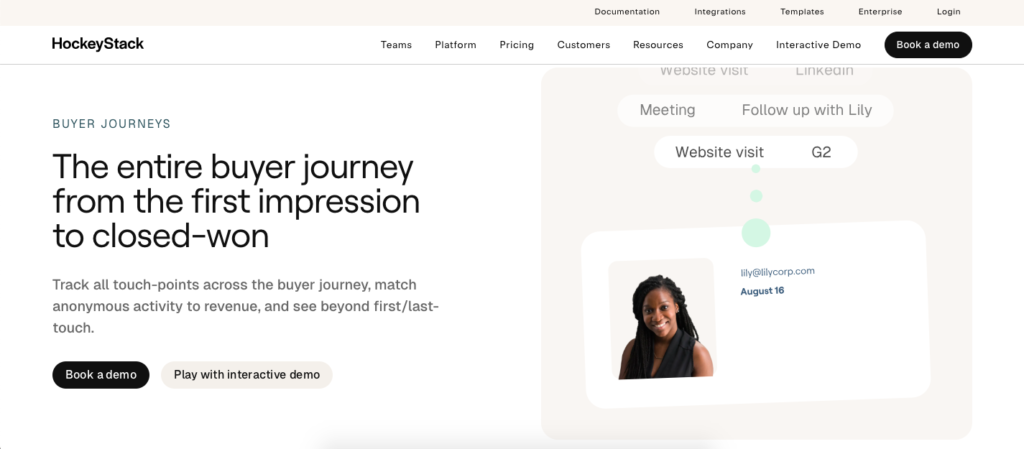
HockeyStack is a marketing analytics and attribution platform designed to provide B2B marketing and sales teams with deep insights into the entire customer journey. By unifying data across various touchpoints, HockeyStack enables organizations to understand which marketing efforts drive revenue, facilitating more informed decision-making.
A standout feature of HockeyStack is its no-code report builder, allowing users to create customized reports without any programming expertise. This flexibility ensures that teams can tailor analytics to their specific needs, enhancing the relevance and actionability of insights.
However, while HockeyStack’s comprehensive data integration is an advantage, it may present a learning curve for users accustomed to more straightforward analytics tools. The platform’s depth and breadth of features might require time and training to fully leverage.
Additionally, as with any advanced analytics solution, the accuracy of insights is contingent upon proper setup and data integration, necessitating careful implementation.
Free template: customer journey touchpoints
Map your marketing touchpoints and understand your users' journey to conversion across all stages
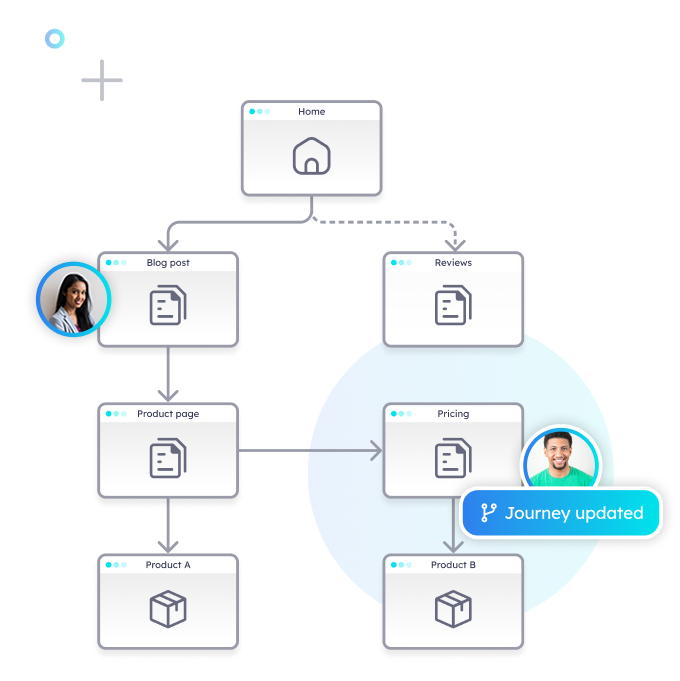
Good for: B2B marketing and sales teams seeking to unify data across touchpoints for customer journey analysis and revenue attribution.
Main features:
- No-code report builder for customized analytics.
- Integration with leading CRM, ABM, marketing automation, and advertising platforms.
- Account-level journey tracking from first impression to closed-won.
- AI-powered insights to identify high-intent accounts and optimize marketing strategies.
Limitations:
- Requires proper setup for accurate data.
- Can be overwhelming for non-technical users.
- Limited support for B2C businesses.
- Smaller ecosystem compared to competitors.
Mixpanel
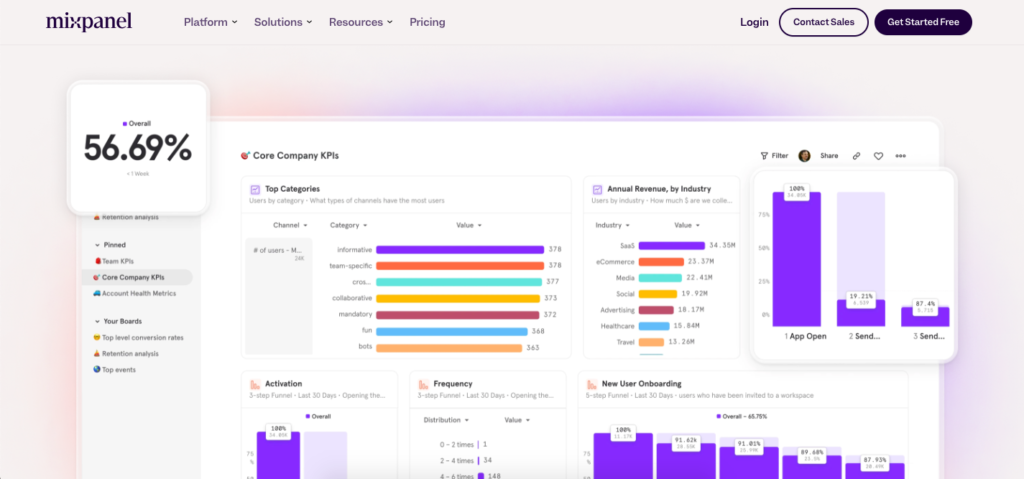
Mixpanel provides in-depth insights into user interactions within web and mobile applications. By focusing on event-based tracking, Mixpanel enables businesses to analyze user behaviors, monitor engagement, and assess retention rates.
This granular approach allows teams to understand how users interact with specific features, facilitating data-driven decisions to enhance product development and user experience.
Mixpanel offers advanced segmentation capabilities, which allow users to break down data by various attributes such as demographics, behaviors, or acquisition channels. This enables businesses to identify patterns within specific user groups and create personalized strategies to optimize user journey. On the other hand, some users have also noted limitations in tracking complex user journeys, which can hinder comprehensive analysis in certain scenarios.
Additionally, Mixpanel offers customizable dashboards and reports, providing teams with real-time insights tailored to their specific metrics and key performance indicators. However, it may not offer the same depth in traditional marketing analytics or SEO tracking as specialized tools.
The platform’s setup and implementation can be resource-intensive, often requiring technical expertise to define and track events accurately. This complexity may pose challenges for smaller teams or organizations lacking dedicated development resources.
Good for: Product teams seeking detailed insights into user behavior and engagement within web and mobile applications.
Main features:
- Event-based tracking for granular analysis of user interactions.
- Advanced segmentation to identify patterns within specific user groups.
- Customizable dashboards and real-time reporting.
- Funnel analysis to monitor conversion rates across user flows.
- Retention analysis to assess user engagement over time.
Limitations:
- Complex implementation.
- Lacks traditional marketing analytics.
- Can be expensive for large-scale usage.
- Not ideal for multi-channel attribution.
SEMrush

SEMrush is a digital marketing platform that offers a suite of tools designed to enhance online visibility and provide deep insights into marketing performance. Its capabilities span across various domains, including SEO, PPC, content marketing, and social media analytics.
The platform is renowned for its robust keyword research features, allowing users to discover high-performing keywords, analyze their competitiveness, and track their rankings over time. Additionally, SEMrush provides detailed site audits to identify technical SEO issues, facilitating the optimization of website structure and content for improved search engine rankings.
A standout feature of SEMrush is its competitive analysis tools. Users can gain insights into their competitors’ strategies by examining their top-performing keywords, backlink profiles, and advertising tactics. This information empowers businesses to identify market gaps and refine their own marketing approaches.
The platform’s extensive range of features can be overwhelming for new users, potentially leading to a steep learning curve. Additionally, while SEMrush offers a free version with limited functionality, access to its more advanced tools and data requires a subscription, which can be costly for small businesses or individual marketers.
Good for: Businesses and marketers seeking a comprehensive tool for SEO, competitive analysis, and content optimization to enhance their online presence.
Main features:
- In-depth keyword research and tracking.
- Comprehensive site audit capabilities.
- Robust competitive analysis tools.
- Content marketing toolkit for SEO-friendly content creation.
- PPC analysis and management features.
Limitations:
- Overwhelming for beginners.
- Data accuracy concerns.
- Expensive for small businesses.
- Limited real-time tracking.
–
When you’re ready to receive useful behavior insights and apply predictive analytics to create personalized experiences, Pathmonk is the partner you’ve been looking for. So why not give Pathmonk a try?
- Try out this interactive demo (without any sales calls!);
- Know more about the product by booking a product tour with our team.


